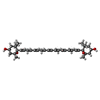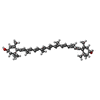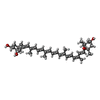+Search query
-Structure paper
| Title | Regulatory dynamics of the higher-plant PSI-LHCI supercomplex during state transitions. |
|---|---|
| Journal, issue, pages | Mol Plant, Vol. 16, Issue 12, Page 1937-1950, Year 2023 |
| Publish date | Dec 4, 2023 |
 Authors Authors | Jianghao Wu / Shuaijiabin Chen / Chao Wang / Weijun Lin / Chao Huang / Chengxu Fan / Dexian Han / Dandan Lu / Xiumei Xu / SenFang Sui / Lixin Zhang /  |
| PubMed Abstract | State transition is a fundamental light acclimation mechanism of photosynthetic organisms in response to the environmental light conditions. This process rebalances the excitation energy between ...State transition is a fundamental light acclimation mechanism of photosynthetic organisms in response to the environmental light conditions. This process rebalances the excitation energy between photosystem I (PSI) and photosystem II through regulated reversible binding of the light-harvesting complex II (LHCII) to PSI. However, the structural reorganization of PSI-LHCI, the dynamic binding of LHCII, and the regulatory mechanisms underlying state transitions are less understood in higher plants. In this study, using cryoelectron microscopy we resolved the structures of PSI-LHCI in both state 1 (PSI-LHCI-ST1) and state 2 (PSI-LHCI-LHCII-ST2) from Arabidopsis thaliana. Combined genetic and functional analyses revealed novel contacts between Lhcb1 and PsaK that further enhanced the binding of the LHCII trimer to the PSI core with the known interactions between phosphorylated Lhcb2 and the PsaL/PsaH/PsaO subunits. Specifically, PsaO was absent in the PSI-LHCI-ST1 supercomplex but present in the PSI-LHCI-LHCII-ST2 supercomplex, in which the PsaL/PsaK/PsaA subunits undergo several conformational changes to strengthen the binding of PsaO in ST2. Furthermore, the PSI-LHCI module adopts a more compact configuration with shorter Mg-to-Mg distances between the chlorophylls, which may enhance the energy transfer efficiency from the peripheral antenna to the PSI core in ST2. Collectively, our work provides novel structural and functional insights into the mechanisms of light acclimation during state transitions in higher plants. |
 External links External links |  Mol Plant / Mol Plant /  PubMed:37936349 PubMed:37936349 |
| Methods | EM (single particle) |
| Resolution | 2.79 - 3.53 Å |
| Structure data |  EMDB-36020: Cryo-EM structure of the Arabidopsis thaliana photosystem I(PSI-LHCII-ST2) EMDB-36021, PDB-8j6z:  EMDB-36022: LHCI of PSI-LHCII from Arabidopsis thaliana(state2)  EMDB-36023: LHCII of PSI-LHCII from Arabidopsis thaliana(state2)  EMDB-36026: Cryo-EM structure of the Arabidopsis thaliana photosystem I in state 2(PSI-ST2)  EMDB-36032: LHCI of PSI from Arabidopsis thaliana in state 2 (PSI-ST2)  EMDB-36033: Cryo-EM structure of the Arabidopsis thaliana PSI in state 1 (PSI-ST1)  EMDB-36035: LHCI of PSI from Arabidopsis thaliana in state 1 (PSI-ST1) EMDB-36036, PDB-8j7a: EMDB-36037, PDB-8j7b: |
| Chemicals |  ChemComp-CHL:  ChemComp-CLA:  ChemComp-XAT:  ChemComp-LHG:  ChemComp-LUT:  ChemComp-BCR:  ChemComp-LMG:  ChemComp-CL0:  ChemComp-SF4:  ChemComp-PQN:  ChemComp-DGD:  ChemComp-NEX: |
| Source |
|
 Keywords Keywords |  PHOTOSYNTHESIS / PHOTOSYNTHESIS /  photosystem I / PSI / photosystem I / PSI /  CELL CYCLE / CELL CYCLE /  photosystem / photosystem /  PLANT PROTEIN PLANT PROTEIN |
 Movie
Movie Controller
Controller Structure viewers
Structure viewers About Yorodumi Papers
About Yorodumi Papers










